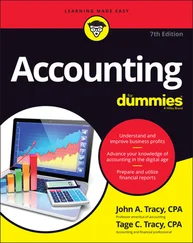HOW TO READ A FINANCIAL REPORT
WRINGING VITAL SIGNS OUT OF THE NUMBERS
Ninth edition
JOHN A. TRACY AND TAGE C. TRACY

Cover Design: Wiley Cover Illustration: Wiley
Copyright © 2020 by John A. Tracy and Tage C. Tracy. All rights reserved.
Published by John Wiley & Sons, Inc., Hoboken, New Jersey.
The Eighth Edition of How to Read a Financial Report: Wringing Vital Signs Out of the Numbers was published by John Wiley & Sons, Inc, in 2014.
Published simultaneously in Canada.
No part of this publication may be reproduced, stored in a retrieval system, or transmitted in any form or by any means, electronic, mechanical, photocopying, recording, scanning, or otherwise, except as permitted under Section 107 or 108 of the 1976 United States Copyright Act, without either the prior written permission of the Publisher, or authorization through payment of the appropriate per-copy fee to the Copyright Clearance Center, Inc., 222 Rosewood Drive, Danvers, MA 01923, (978) 750-8400, fax (978) 646-8600, or on the Web at www.copyright.com. Requests to the Publisher for permission should be addressed to the Permissions Department, John Wiley & Sons, Inc., 111 River Street, Hoboken, NJ 07030, (201) 748-6011, fax (201) 748-6008, or online at http://www.wiley.com/go/permissions.
Limit of Liability/Disclaimer of Warranty: While the publisher and author have used their best efforts in preparing this book, they make no representations or warranties with respect to the accuracy or completeness of the contents of this book and specifically disclaim any implied warranties of merchantability or fitness for a particular purpose. No warranty may be created or extended by sales representatives or written sales materials. The advice and strategies contained herein may not be suitable for your situation. You should consult with a professional where appropriate. Neither the publisher nor author shall be liable for any loss of profit or any other commercial damages, including but not limited to special, incidental, consequential, or other damages.
For general information on our other products and services or for technical support, please contact our Customer Care Department within the United States at (800) 762-2974, outside the United States at (317) 572-3993 or fax (317) 572-4002.
Wiley publishes in a variety of print and electronic formats and by print-on-demand. Some material included with standard print versions of this book may not be included in e-books or in print-on-demand. If this book refers to media such as a CD or DVD that is not included in the version you purchased, you may download this material at http://booksupport.wiley.com. For more information about Wiley products, visit www.wiley.com.
Library of Congress Cataloging-in-Publication Data:
Names: Tracy, John A., author. | Tracy, Tage C., author.
Title: How to read a financial report: wringing vital signs out of the
numbers / John A. Tracy and Tage C. Tracy.
Description: Ninth edition. | Hoboken, New Jersey : Wiley, [2020] |
Includes index.
Identifiers: LCCN 2019035972 (print) | LCCN 2019035973 (ebook) | ISBN
9781119606468 (paperback) | ISBN 9781119606451 (Adobe PDF) | ISBN
9781119606482 (epub)
Subjects: LCSH: Financial statements.
Classification: LCC HF5681.B2 T733 2020 (print) | LCC HF5681.B2 (ebook) |
DDC 657/.3—dc23
LC record available at https://lccn.loc.gov/2019035972LC ebook record available at https://lccn.loc.gov/2019035973
1 Cover
2 PREFACE TO THE NINTH EDITION PREFACE TO THE NINTH EDITION This book has stood the test of time and reminds all of us that fortifying your understanding of financial reports and statements has been, is, and will always be essential evergreen knowledge. After 40 years in print, spanning nine editions, it has survived countless economic and financial challenges—and is still going strong. My son Tage joined me as coauthor in the previous edition, and I willingly share credit with him for the book’s continued success. This edition catches up with major changes in financial reporting since the eighth edition was released in 2013. It also expands our discussion on how financial results are communicated. At the same time, however, the architecture of the book remains unchanged. The framework of the book has proved very successful for 40 years so I’d be a fool to mess with this winning formula. (My mother did not raise a fool.) Cash flows are underscored throughout the book and remain a central focus of the current edition. In business, everything starts and ends with cash flow, which is a concept we never stray too far from. As with all previous editions, our book explains the connectivity of the different pieces of information reported in financial statements. In reading financial statements you need to know how the different elements are connected. You cannot grab one piece of information in one place and ignore its other dimensions and contexts. Financial statements are, essentially, spreadsheets, although they do not demonstrate what’s connected to what. We have prepared all the exhibits in the book as Excel worksheets. To request a copy of the workbook file of all the exhibits, please feel free to contact one of us via email (me at tracyj@colorado.edu or Tage at tagetracy@cox.net). In summary, I express my sincere thanks to all of you who have sent compliments about our book. The royalties from sales of the book are nice, but the messages from readers form the real icing on the cake. Not many books of this ilk make it to the ninth edition. It takes a good working partnership between the author and the publisher. I most sincerely thank the many people at John Wiley & Sons who have worked with me over four decades. Gordon B. Laing was my original editor and sponsor of the book. His superb editing was a blessing. I couldn’t have done it without him. JOHN A. TRACY Boulder, Colorado August 2019
3 Part One FUNDAMENTALS Part One FUNDAMENTALS
1 STARTING WITH CASH FLOWS Summary of Cash Flows for a Business What Does Cash Flows Summary Not Tell You? Profit Is Not Measured by Cash Flows Cash Flows Do Not Reveal Financial Condition A Final Note Before Moving On 2 TWO BEDROCK FINANCIAL STATEMENTS Need for Financial Information Reporting Profit Performance: The Income Statement Reporting Financial Condition: The Balance Sheet 3 REPORTING CASH FLOWS Statement of Cash Flows Cash Versus Accrual Accounting Financial Tasks of Business Managers 4 FITTING TOGETHER FINANCIAL STATEMENTS One Problem in Financial Reporting Connecting the Dots
4 Part Two CONNECTIONS 5 SALES REVENUE AND ACCOUNTS RECEIVABLE Exploring One Link at a Time How Sales Revenue Drives Accounts Receivable Accounting Issues 6 COST OF GOODS SOLD EXPENSE AND INVENTORY Holding Products in Inventory Until They Are Sold Inventory Control Accounting Issues 7 INVENTORY AND ACCOUNTS PAYABLE Acquiring Inventory on the Cuff Accounting Issues 8 OPERATING EXPENSES AND ACCOUNTS PAYABLE Recording Expenses Before They Are Paid Accounting Issues 9 OPERATING EXPENSES AND PREPAID EXPENSES Paying Certain Operating Costs Before They Are Recorded as Expenses Accounting Issues: Using Prepaid Expenses to Massage the Numbers 10 DEPRECIATION EXPENSE AND PROPERTY, PLANT, AND EQUIPMENT Overview of Expense Accounting Depreciation Expense Accumulated Depreciation and Book Value of Fixed Assets Book Values and Current Replacement Costs Intangible Assets Accounting Issues 11 ACCRUING LIABILITY FOR UNPAID EXPENSES Recording Accrued Liability for Operating Expenses Bringing Interest Expense Up to Snuff Accounting Issues 12 INCOME TAX EXPENSE AND ITS LIABILITY Taxation of Business Profit Accounting Issues 13 NET INCOME AND RETAINED EARNINGS, AND EARNINGS PER SHARE (EPS) Net Income into Retained Earnings Earnings per Share (EPS) Accounting Issues 14 CASH FLOW FROM OPERATING (PROFIT-SEEKING) ACTIVITIES Profit Versus Cash Flow from Profit Changes in Assets and Liabilities That Impact Cash Flow from Operating Activities The Direct Method for Reporting Cash Flow from Operating Activities Profit Before the Bottom Line Accounting Issues 15 CASH FLOWS FROM INVESTING AND FINANCING ACTIVITIES Completing the Statement of Cash Flows Seeing the Big Picture of Cash Flows Accounting Issues
Читать дальше













